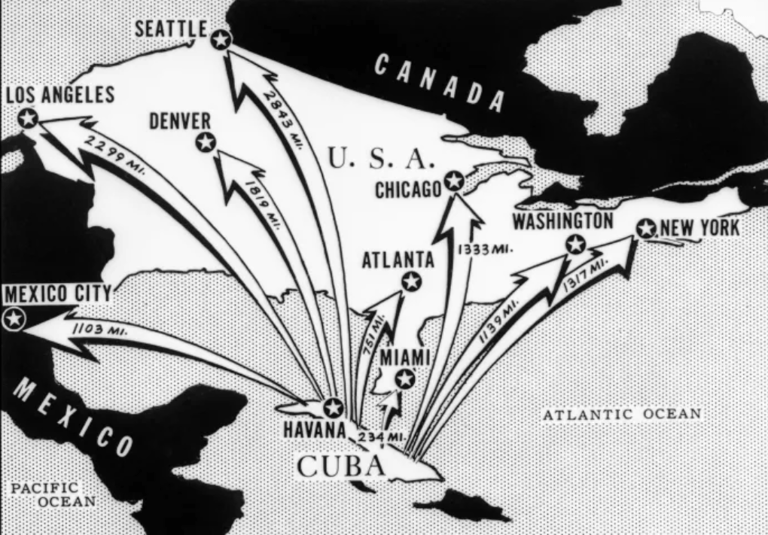Cuban Missile Crisis: A Cold War Flashpoint


The Cuban Missile Crisis of 1962 stands as one of the most critical moments in world history, where the world came perilously close to a nuclear war. It was a 13-day political and military standoff between the United States and the Soviet Union over the placement of Soviet nuclear missiles in Cuba. This crisis not only highlighted the dangers of nuclear brinkmanship during the Cold War but also paved the way for diplomatic mechanisms to manage such conflicts. For UPSC and MPSC aspirants, the Cuban Missile Crisis is a significant topic as it reveals the intricacies of Cold War politics, the role of diplomacy and lessons in crisis management.
Background of the Cuban Missile Crisis
1. Cold War Context
After World War II, the Cold War rivalry between the United States and the Soviet Union dominated global politics. The arms race, ideological conflicts, and proxy wars in different parts of the world created a tense international environment.
2. Cuba's Strategic Importance
In 1959, Fidel Castro's communist revolution in Cuba alarmed the U.S., given its proximity (90 miles) to Florida.
The U.S. imposed an embargo on Cuba and supported the failed Bay of Pigs invasion in 1961, further pushing Cuba closer to the Soviet Union.
3. Soviet Strategy
Nikita Khrushchev, the Soviet Premier, saw an opportunity to strengthen ties with Cuba while countering U.S. influence in the Western Hemisphere. Deploying nuclear missiles in Cuba would offset U.S. missile deployments in Turkey and Italy, which directly threatened the Soviet Union.
Timeline of the Crisis
1. Discovery of Missiles (October 14, 1962)
A U-2 reconnaissance flight revealed Soviet missile sites under construction in Cuba. These missiles had the capacity to strike most of the U.S. mainland.
2. President Kennedy's Response
October 22, 1962: U.S. President John F. Kennedy addressed the nation, announcing a "quarantine" (naval blockade) of Cuba to prevent further Soviet shipments of missiles.
He demanded the immediate dismantling and removal of the missile sites.
3. Tense Negotiations
Khrushchev and Kennedy exchanged multiple letters and communications.
The Soviet Union justified the deployment as defensive, while the U.S. viewed it as an offensive threat.
4. Peak of the Crisis
October 24, 1962: Soviet ships heading towards Cuba stopped or turned back to avoid confrontation with the U.S. naval blockade.
Tensions reached a peak on October 27, 1962, when a U.S. U-2 spy plane was shot down over Cuba.
5. Resolution (October 28, 1962)
Khrushchev agreed to remove the missiles from Cuba in exchange for a U.S. public pledge not to invade Cuba and a secret agreement to remove American missiles from Turkey.
Significance of the Cuban Missile Crisis
1. Avoidance of Nuclear War
The crisis is considered the closest the world has ever come to a full-scale nuclear war. Both superpowers realized the catastrophic consequences of nuclear conflict.
2. Diplomatic Success
The resolution of the crisis showcased the importance of backchannel diplomacy and direct communication between leaders. It led to the establishment of the Moscow-Washington hotline to prevent future miscommunications.
3. Balance of Power
The crisis highlighted the strategic balance of power and underscored the dangers of nuclear brinkmanship.
4. Impact on the Cold War
The U.S. emerged as a more resolute global power, while Khrushchev faced criticism within the Soviet Union for perceived capitulation.
Cuba remained a focal point in the Cold War, continuing its alliance with the Soviet Union.
Lessons from the Crisis
1. The Role of Leadership
The steady leadership of Kennedy and Khrushchev prevented the escalation of the crisis. Decision-making under pressure proved crucial.
2. Importance of Communication
The crisis demonstrated the need for effective communication between rival states. The hotline established post-crisis remains a symbol of this lesson.
3. Arms Control
The Cuban Missile Crisis laid the groundwork for arms control agreements like the Nuclear Test Ban Treaty (1963) and later the Non-Proliferation Treaty (NPT).
Relevance for UPSC and MPSC Examinations
1. Cold War Politics
The Cuban Missile Crisis is a key case study to understand the dynamics of U.S.-Soviet rivalry during the Cold War.
2. International Relations
The crisis highlights the importance of diplomacy, negotiation and crisis management in global politics.
3. Lessons in Strategic Decision-Making
For governance and policy-making, the Cuban Missile Crisis is a valuable example of leadership under pressure, negotiation tactics and strategic foresight.
4. India's Non-Aligned Movement (NAM)
The crisis unfolded during the peak of the NAM, led by countries like India. It reinforces the significance of non-alignment in maintaining global peace during bipolar conflicts.
Conclusion
The Cuban Missile Crisis remains one of the most critical moments in modern history, symbolizing both the dangers of nuclear brinkmanship and the power of diplomacy. It served as a wake-up call for the global community to address the risks of nuclear weapons and develop mechanisms for crisis prevention. For aspirants of UPSC and MPSC, studying this crisis provides valuable insights into Cold War geopolitics, international diplomacy and lessons in conflict resolution that continue to resonate in today's multipolar world.
